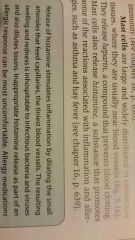![]()
![]()
![]()
Use LEFT and RIGHT arrow keys to navigate between flashcards;
Use UP and DOWN arrow keys to flip the card;
H to show hint;
A reads text to speech;
30 Cards in this Set
- Front
- Back
|
Histology
|
Study of tissues
|
|
|
Intercellular Junctions
|
connects the membrane with tightly packed cell types
|
|
|
Tissues
|
layers or groups of similar cells with a common function
|
|
|
Epithelial Tissues
|
tissues found through out the free body surfaces exposed
|
|
|
Basement Membrane
|
thin non living layer anchors epithelium to underlying connective tissue
|
|
|
Glandular Epithelium
|
cells specialized to produce and secrete substances into ducts or into body fluids
|
|
|
exocrine glands
|
glands that secrete products into ducts open onto surfaces like skin or lining of digestive tract
|
|
|
Endocrine glands
|
glands that secret products into tissue fluid or blood
|
|
|
Connective tissue
|
bind structures support and protect, most common
|
|
|
Extracellular matrix
|
protein fibers and a ground substance consisting of non fiborous protein and other molecules
|
|
|
fibroblast
|
most common cell type, star shaped, produce fibers by secreting proteins into the extra cellular matrix of connective tissues
|
|
|
Macrophages
|
clears foreign particles from tissues, originate as white blood cells, phagocytosis
|
|
|
mast cells
|

|
|
|
Collagenous fibers
|
thick threads of the protein collagen strong, hold structures together
|
|
|
Collagen
|
structural protein
|
|
|
ligaments
|
connect bones to bones
|
|
|
tendons
|
connect muscles to bones
|
|
|
elastic fibers
|
complex networks in in various tissues, elastic and return to normal shape,
|
|
|
elstin
|
springlike protein
|
|
|
adipose tissue
|
fat, develops when certain cells store fat in cytoplasm enlarge
|
|
|
cartilage
|
rigid connective tissue, support, Frame works, protects underlying tissues, structural models for bones
|
|
|
chondrocytes
|
cartilage cells lay in small chamber called lacunae and lie completely within the extracellular matrix
|
|
|
bone
|
most rigid connective tissue protects vital structures
|
|
|
blood
|
cells suspended in fluid include red and white blood cells
|
|
|
epithelial membranes
|
thin structures usually composed of epithelium and underlying connective tissue
|
|
|
muscle tissues
|
contractile, can shorten and thicken pull attached ends to move body parts
|
|
|
skeletal muscle tissue
|
forms muscles that usually attach to bones and are controlled by conscious effort
|
|
|
smooth muscle tissue
|
cells lack striations, shorter then skeletal,
|
|
|
cardiac muscle tissue
|
only in heart joined end to end
|
|
|
nervous tissue
|
found in brain spinal cord peripheral nerves, neurons and highly specialized
|

